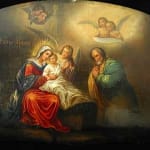The Birth of Christ, 18th Century CE - 19th Century CE
Oil on Wood Panel
13.25 x 11.25
PF.5798
Further images
Russians inherited the tradition of icon painting from Byzantium, where it began as an offshoot of the mosaic and fresco tradition. During the 8th and 9th centuries, the iconoclastic controversy...
Russians inherited the tradition of icon painting from Byzantium, where it began as an offshoot of the mosaic and fresco tradition. During the 8th and 9th centuries, the iconoclastic controversy in the Orthodox Church called into question whether religious images were a legitimate practice or sacrilegious idolatry. Although the use of images was in the end permitted, a thorough distinction between profane art intended to depict reality and sacred art designed for spiritual contemplation was established. That difference is one of the reasons that the artistic style of icons can seem so invariant. Certain kinds of balance and harmony became established as reflections of divinity, and as such they invited careful reproduction and subtle refinement rather than striking novelty. Although this philosophy resulted in a comparatively slow evolution of style, icon painting evolved considerably over the centuries. Unlike the pictorial traditions of the west that aspire towards increased realism and naturalism, the essence of Russian icon painting is not about the representation of physical space or appearance. Icons are images intended to aid in contemplative prayer, and in that sense, are more concerned with conveying meditative harmony than with laying out a realistic scene. They were not painted to please the eye of the mind, but to inspire reflection and self-examination.
This icon is a masterpiece of Russian painting. The tenderness of the composition is matched by the compassion of the figural style. Alas the painter appears to be influenced more by the great masters of the Italian Renaissance than by the traditional Byzantine predecessors. Except for the apparition of angels and the holy auras of light radiating from the central figures, this scene might appear to be a close moment shared by any ordinary family as they welcome an addition to their home. It is the warmth and intimacy of the family that makes this painting so stunning. Mary gently places her right hand upon the infant Christ’s belly as he places his arm over her wrist and gazes in awe upon his mother. Mother and father both share a knowing look towards each other as Joseph kneels and prays, both his hands held together over his heart. A divine light shines down upon the holy figures from above, rendered in gold leaf to achieve a stunning effect of luminosity and brilliance as it highlights the folds of their drapery. Angels emerge from the parted clouds, looking down in reverence at their newborn king. A larger, full figured angel also stands alongside Christ, holding his hands together in a pose echoing that of Joseph. The absolute mastery of the painter is evident in the loose brushstrokes of the foreground. The actual bristles of the paintbrush are evident as are the individual strokes that rendered the ground. Furthermore, blades of grass covered in shadows effectively recess the immediate foreground, a technique commonly employed in theatrical sets. This composition almost appears as if it was an act out of a great play. The lighting, setting, and arrangement of figures all could easily be transferred to the stage. Thus the genius of the painter becomes more evident. Every detail of this icon coexists in perfect balance with each other that, when viewed as a whole, achieves complete and total harmony. Overall this icon is a true rarity, one of the few cases where subject, composition, and technique all complement each other and in effect work together to heighten the aesthetic and spiritual beauty of the painting.
This icon is a masterpiece of Russian painting. The tenderness of the composition is matched by the compassion of the figural style. Alas the painter appears to be influenced more by the great masters of the Italian Renaissance than by the traditional Byzantine predecessors. Except for the apparition of angels and the holy auras of light radiating from the central figures, this scene might appear to be a close moment shared by any ordinary family as they welcome an addition to their home. It is the warmth and intimacy of the family that makes this painting so stunning. Mary gently places her right hand upon the infant Christ’s belly as he places his arm over her wrist and gazes in awe upon his mother. Mother and father both share a knowing look towards each other as Joseph kneels and prays, both his hands held together over his heart. A divine light shines down upon the holy figures from above, rendered in gold leaf to achieve a stunning effect of luminosity and brilliance as it highlights the folds of their drapery. Angels emerge from the parted clouds, looking down in reverence at their newborn king. A larger, full figured angel also stands alongside Christ, holding his hands together in a pose echoing that of Joseph. The absolute mastery of the painter is evident in the loose brushstrokes of the foreground. The actual bristles of the paintbrush are evident as are the individual strokes that rendered the ground. Furthermore, blades of grass covered in shadows effectively recess the immediate foreground, a technique commonly employed in theatrical sets. This composition almost appears as if it was an act out of a great play. The lighting, setting, and arrangement of figures all could easily be transferred to the stage. Thus the genius of the painter becomes more evident. Every detail of this icon coexists in perfect balance with each other that, when viewed as a whole, achieves complete and total harmony. Overall this icon is a true rarity, one of the few cases where subject, composition, and technique all complement each other and in effect work together to heighten the aesthetic and spiritual beauty of the painting.









